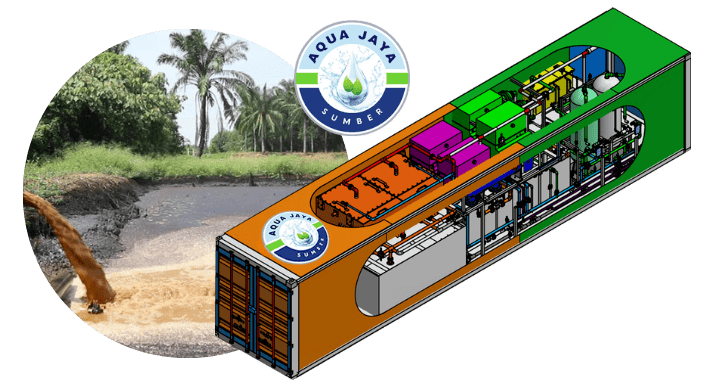POME
PALM OIL FACTORY LIQUID WASTE (POME)
Extraction of Fresh Fruit Bunches (FFB) from palm oil will produce liquid waste called palm oil mill liquid waste (POME). In the old-fashioned extraction process, three significant activities will produce large amounts of POME:
– Sterilizing fresh fruit bunches
– Clarification of extracted crude palm oil: pressing station, separation, clarification
– EFB pressing
The factory emits approximately 0.6 cubic meters of POME for every tonne of fresh fruit bunches processed. Fresh POME is hot (temperature 60-80°C), acidic (pH 3.3-4.6), thick brownish liquid with high solids, oil and fat, COD, and Biological Oxygen Demand (BOD) values.
Current View of Biological Methods

Developments in POME Processing

- Aqua Jaya Resources Sdn Bhd Advanced Hybrid Electro-Chemical Technology is a combination of Electro-Coagulation & Electro-Oxidation (AquaEco) processes
- AquaEco is a new generation technology in processing Palm Oil Factory Liquid Waste (POME) thereby creating sustainability in the palm oil industry
- It is an affordable technology for processing Palm Oil Factory Liquid Waste (POME) which contains a lot of oil & fat, suspended solids, organic and non-organic contamination.
ELECTRO-COAGULATION
Process in which flocculated metal ions are added electrolytically to polluted water in the anode, and gas microbubbles are released back at the cathode.
The reactive and excited states will cause contaminants to be released from the water and destroyed or made less soluble.
ELECTRO-OXIDATION
Transfer of electrons to or from molecules or ions changes the oxidation state (H+, OH-ions, H2O and electrons)
The process will oxidize organic compounds and dissolved ammonia, sulfides, etc., to become carbon dioxide, water, nitrogen, and simple salts .
Aqua Jaya Resources Sdn Bhd is the Solution for POME Processing

100% of companies and other innovations in Indonesia must meet waste disposal standards from the Ministry of Environment and Forestry (KLHK).
Use of the System as a Service (SaaS) model – affordable, efficient & effective.
So that liquid waste can be reused, organic sludge can be used as fertilizer, and produce green hydrogen as clean energy.
Efficient Technology in Cleaning
AquaEco’s Advanced Hybrid Electro-Chemical Waste Treatment System complies with the provisions and recommendations of the Ministry of Environment and Forestry in processing RAW POME & ANAEROBIC POME.
Waste processing system that can remove organics, suspended solids, turbidity, odors, colors, fats, oils & lubricants and heavy metals.